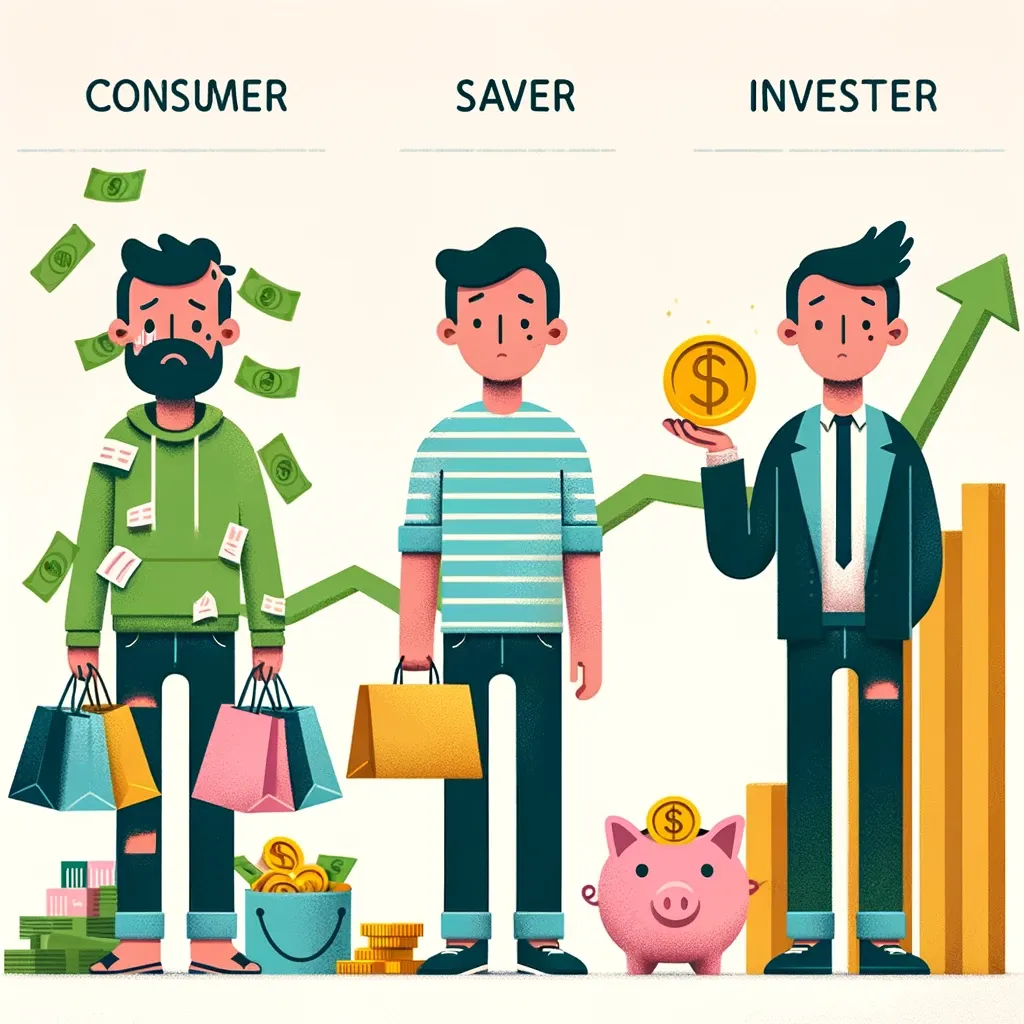Consumers, Savers, and Investors:
1. Consumer:
Definition: At the core, a consumer is an individual who primarily focuses on spending their income on goods and services for immediate or near-term satisfaction. This category is characterized by a consumption-oriented mindset, where financial resources are used predominantly for acquiring lifestyle items, experiences, or day-to-day necessities.
Key Characteristics:
Spending Focused: Prioritizes current consumption over saving or investing.
Short-term Perspective: Decisions are often driven by immediate needs or desires rather than long-term financial planning.
Potential Risk: Tendency to accumulate debt or live paycheck to paycheck without accumulating significant savings or assets.
2. Saver:
Definition: A saver is an individual who systematically sets aside a portion of their income for future use. Unlike consumers, savers are more focused on financial security and stability. They prioritize building a reserve of funds for emergencies, specific goals, or future needs.
Key Characteristics:
Security Oriented: Emphasizes saving money for a sense of security or to meet specific financial goals (e.g., purchasing a home, funding education).
Risk-Averse: Generally cautious about taking financial risks and prefers preserving capital over seeking high returns.
Longer-term Perspective: While not necessarily focused on wealth creation, savers look beyond immediate consumption and plan for future financial needs.
3. Investor:
Definition: Investors take the concept of saving a step further by allocating their capital into assets such as stocks, bonds, real estate, or other investment vehicles with the expectation of generating future income, appreciation, or both. Investing involves a level of risk, but with the potential for higher returns compared to traditional saving.
Key Characteristics:
Growth Oriented: Looks to grow wealth over time through investments that yield returns above inflation and savings rates.
Informed Risk-Taking: Willing to accept some level of risk for the potential of higher returns, recognizing that investments can fluctuate in value.
Long-term Wealth Building: Focuses on accumulating assets that increase in value over time, often with a long-term horizon and compound interest working in their favor.
Lifestyle and Mindset of Each Category:
1. Consumer:
- Living for the Now: Consumers typically embrace a lifestyle that prioritizes immediate gratification. Their financial decisions are often driven by current desires, such as the latest gadgets, fashion, or experiences.
- Mindset: The consumer mindset is often shaped by a belief in enjoying life in the present, sometimes at the expense of future financial security. This approach can lead to a cycle of continuous spending and immediate fulfillment, but often lacks long-term financial planning. The consumer mindset revolves around the belief that life is short-lived and unpredictable. This viewpoint justifies their behavior of enjoying life to the fullest in the present, often at the expense of future financial security. The mantra 'live for today because tomorrow is uncertain' frequently underpins their financial decisions.
- Impact on Financial Health: While this lifestyle can offer short-term happiness, it may lead to financial challenges, such as lack of savings, debt accumulation, and vulnerability to financial emergencies.
2. Saver:
- Prudence and Preparation: Savers generally lead a more calculated lifestyle, prioritizing financial security and stability. They tend to budget carefully, avoid unnecessary debts, and set aside funds for future needs or emergencies.
- Mindset: The saver's mindset is characterized by caution and foresight. There's an inherent focus on building a financial cushion, which provides a sense of security and peace of mind.
- Impact on Quality of Life: This approach often ensures a stable and less financially stressful life. However, excessive caution may lead to missed opportunities for higher financial growth through investing.
3. Investor:
- Strategic and Growth-Focused: Investors typically lead a lifestyle that balances current needs with long-term financial goals. They are willing to take calculated risks for potential higher returns, dedicating time to learning about financial markets and investment strategies.
- Mindset: The investor mindset is growth-oriented and forward-looking. Investors understand the power of compounding and are willing to weather short-term market fluctuations for long-term gains.
- Lifestyle Implications: This approach often leads to wealth accumulation and financial independence. However, it requires patience, discipline, and a tolerance for risk.
Financial Implications and Growth Potential:
1. Consumer:
- Immediate Consumption vs. Long-term Wealth: The consumer lifestyle, focused on immediate consumption, often leads to minimal asset accumulation. Frequent spending leaves little room for savings or investments.
- Growth Potential: The growth potential in this category is limited, as funds are typically spent rather than invested. The lack of investments means consumers miss out on potential compounding gains and wealth accumulation over time.
- Risks: When faced with unforeseen financial emergencies, consumers, who typically prioritize immediate spending, may find themselves in a precarious position. Lacking sufficient savings, their common recourse is to resort to additional borrowing. This approach, however, can compound their financial challenges, as the accumulation of debt adds further strain to their finances. In some cases, this cycle of borrowing and spending can lead to a significant financial crisis, potentially undermining their financial stability and well-being. It's a situation that underscores the risks associated with a consumption-focused financial strategy devoid of adequate emergency planning.
Investor Central is a reader-supported publication. To receive new posts and support my work, consider becoming a free or paid subscriber.
2. Saver:
- Stable Savings and Security: Savers prioritize building a financial reserve, which provides stability and security. However, savings typically grow at a slower rate, often just keeping pace with or slightly above inflation.
- Growth Potential: While savings offer safety, they usually have limited growth potential compared to investments. The primary growth comes from interest accrual, which is often low.
- Missed Investment Opportunities: Savers, in prioritizing security, may miss out on higher returns that could be gained through investing in the stock market or other higher-yielding assets.
3. Investor:
- Compounding and Wealth Accumulation: Investors put their money to work with the aim of generating higher returns. Investing, especially with a focus on long-term compounding, can significantly boost wealth accumulation.
- Growth Potential: The potential for growth is much higher for investors, given the broader range of investment options like stocks, bonds, real estate, and mutual funds, which historically outperform traditional savings.
- Risk and Reward Balance: Investors need to manage risk effectively. While the potential for higher returns is greater, it comes with increased market risk. Proper diversification and risk management are key.
Transitioning from Consumer to Saver:
Understanding the Need for Change:
- Recognize the long-term impacts of a consumer lifestyle, such as lack of savings and increased debt. Acknowledgment of these risks is the first step towards change.
Budgeting and Expense Management:
- Implement a structured budget to track and control spending. Prioritize essential expenses and reduce discretionary spending.
- Tools like budgeting apps or spreadsheets can be effective in managing finances.
Debt Reduction Strategies:
- Focus on paying down high-interest debts such as credit card balances.
- Consider debt consolidation or negotiation for more manageable repayment terms.
Building an Emergency Fund:
- Start setting aside a portion of income into an emergency fund, aiming for an initial goal of three to six months' worth of living expenses.
Setting Financial Goals:
- Define clear, achievable financial goals (like saving for a down payment on a house or funding education) to motivate and guide savings efforts.
Adopting a Saver’s Mindset:
- Cultivate a mindset that values financial security and future well-being over immediate gratification.
- Regularly remind oneself of the benefits of saving, like reduced financial stress and increased stability.
Moving from Saver to Investor:
Understanding Investment Basics:
- Educate oneself on basic investment concepts and the various types of investment vehicles (stocks, bonds, mutual funds, etc.).
- Resources like books, online courses, or financial workshops can be valuable.
Assessing Risk Tolerance:
- Evaluate personal risk tolerance to understand which types of investments are suitable.
- Consider factors like investment time horizon, financial goals, and emotional comfort with market fluctuations.
Starting with Low-Risk Investments:
- Begin with less risky investments like index funds or conservative mutual funds to get accustomed to the investing world.
- Gradually diversify into other types of investments as comfort and understanding grow.
Learning to Diversify:
- Understand the importance of diversification in reducing risk. A well-diversified portfolio includes a mix of different asset classes.
Seeking Professional Advice:
- Consider consulting with a financial advisor for personalized investment advice, especially when dealing with more complex investment decisions.
Regular Investment and Review:
- Start investing regularly, possibly through automated investment plans like dollar-cost averaging.
- Periodically review and adjust the investment portfolio based on performance and changing financial goals.
Risk Management and Financial Education:
Understanding and Managing Risks:
- Concept: Transitioning from saving to investing involves understanding the inherent risks associated with different investment types. This includes market risk, interest rate risk, and the risk of capital loss.
- Strategy: Develop a risk management plan that aligns with your investment goals and risk tolerance. This can involve setting stop-loss orders, diversifying your portfolio, or allocating assets strategically across different investment classes.
The Importance of Financial Education:
- Continuous Learning: As you move into investing, it's crucial to continually educate yourself about financial markets, investment products, and economic factors that influence investment returns.
- Resources: Leverage books, online courses, seminars, and financial news to stay informed. Consider following reputable financial experts or joining investor communities for shared learning experiences.
Developing a Long-term Investment Perspective:
- Patience and Persistence: Understand that investing is a long-term endeavor. Short-term market fluctuations should not deter your overall investment strategy.
- Goal Alignment: Regularly review and ensure that your investment choices are aligned with your long-term financial goals, such as retirement planning or wealth accumulation.
Evaluating Investment Opportunities:
- Due Diligence: Before making investment decisions, conduct thorough research. Analyze the fundamentals of investment options and understand the factors that could impact their performance.
- Seeking Professional Advice: For more complex investment decisions, consider consulting with financial advisors or investment professionals.
Staying Informed on Market Trends and Economic Indicators:
- Market Awareness: Keep abreast of current market trends, economic reports, and political events that might impact your investments.
- Adaptability: Be prepared to adjust your investment strategy in response to significant market changes or shifts in economic indicators.
Navigating Financial Tools and Technology:
- Utilizing Tools: Embrace financial tools and technology that can assist in managing investments, such as portfolio trackers, analytical software, or robo-advisors.
- Tech Literacy: Develop an understanding of how different technological tools can aid in investment analysis and decision-making processes.
Author's Perspective: Balancing Today and Tomorrow
Let's set aside theory for a moment. It's important to clarify that consuming in itself isn't inherently negative, nor can we overlook the significance of living in the present. Life, indeed, must be savored. However, this realization shouldn't be a gateway to unrestrained spending or acquiring things we don't genuinely need. Warren Buffett wisely remarked, "If you buy things you do not need, soon you will have to sell things you need." This serves as a cautionary reminder against the pitfalls of immediate gratification and excessive consumption.
As a practical starting point, I highly recommend "The Richest Man in Babylon" by George S. Clason. It's an excellent guide for those beginning their financial journey.
A tangible first step is to earmark 10% of your income for savings. This simple act propels you into the saver category. Aim to build an emergency fund that covers six months of expenses. For safekeeping, I suggest considering gold as an option. Particularly in countries like India, gold has shown to not only be less volatile but also to historically outperform inflation, sometimes even surpassing stock market returns.
The journey requires patience and discipline. Make it a rule to never dip into that 10% savings. As your income grows, gradually increase this allocation to 20%, 30%, or more. But resist the urge to proportionally increase your lifestyle expenses as your salary increases.
Most importantly, steer clear of unnecessary consumer debt, a trap that can derail financial stability.
By following these steps, you'll witness a transformation in your financial health. The paycheck-to-paycheck living will be a thing of the past. With a solid six-month emergency fund, you'll gain the freedom to make bolder, more informed decisions – choices that might have seemed unattainable while trapped in the consumer category. Your financial growth and peace of mind will be the rewards of this disciplined approach.






